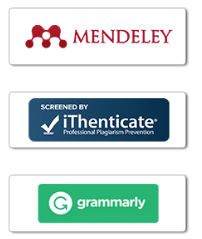THE DEVELOPMENT OF THE "ULTACO" GAME MEDIA ON MATHEMATICS LEARNING CONTENT FOR BUILDING SPACE SURFACE AREA IN CLASS V ELEMENTARY SCHOOL STUDENTS
DOI:
https://doi.org/10.26555/jpsd.v8i2.a22125Keywords:
Ultaco, Geometry content, Elementary schoolAbstract
This development research aims to produce an Ultaco game media that is suitable for use in mathematics learning on the surface area of geometric shapes for fifth-grade elementary school students. The use of media is very necessary for learning mathematics because it helps students to understand the material well, does not saturate, can increase student activity and interest during learning. The product feasibility test is based on the results of the assessments of material experts, media experts, fifth-grade teachers and fifth-grade elementary school students as test subjects. The results of research and development of Ultaco game media can be concluded as follows: (1) The results of the assessment of material experts get a percentage of 79 .4% is included in the appropriate category, (2) the media expert's assessment gets a percentage of 95% including the very feasible category, (3) the assessment from the fifth-grade teacher gets a percentage of 85.3% including the very feasible category. Meanwhile, from users, Ultaco game media obtained a percentage of 79.4%, so that it can be categorized as feasible and interesting to use as learning mediaReferences
Ball, S. J. (2003). The teachers soul and the terrors of performativity. Journal of Education Policy, 18(2), 215-228.
Boyle, D. G. (2013). A students guide to Piaget. Elsevier.
Delwiche, A. (2006). Massively multiplayer online games (MMOs) in the new media classroom. Journal of Educational Technologyand Society, 9(3), 160.
Denton, M., Borrego, M., & Boklage, A. (2020). Community cultural wealth in science, technology, engineering, and mathematics education: A systematic review. Journal of Engineering Education, 109(3), 55658-0.
Gellert, U. (2001). Mathematics and life: lessons from history. International Journal of Mathematical Education in Science and Technology, 32(3), 365-374.
Gunawan, I. (2017). Indonesian Curriculum 2013: Instructional management, obstacles faced by teachers in implementation and the way forward. 3rd International Conference on Education and Training (ICET 2017). Atlantis Press.
Keller, J., & Suzuki, K. (2004). Learner motivation and e-learning design: A multinationally validated process. Journal of Educational Media, 29(3), 229-239.
Lubinski, D., & Benbow, C. P. (2006). Study of mathematically precocious youth after 35 years: Uncovering antecedents for the development of math-science expertise. Perspectives on Psychological Science, 1(4), 316-345.
Maba, W. (2017). Teachers Perception on the Implementation of the Assessment Process in 2013 Curriculum. International Journal of Social Sciences and Humanities (IJSSH), 1(2), 1-9.
Mellon, C. A., & Sass, E. (1981). Perry and Piaget: Theoretical framework for effective college course development. Educational Technology, 21(5), 29-33.
Orowala, S. M. (2017). Pengembangan Media Ular Tangga pada Materi Pokok Mengenal Bangun Datar dalam Subtema Anggota Keluargaku untuk Siswa Kelas 1 Sekolah Dasar. Universitas Sanata Dharma.
Pajares, M. F. (1992). Teachers beliefs and educational research: Cleaning up a messy construct. Review of Educational Research, 62(3), 307-332.
Plucker, J. A., Beghetto, R. A., & Dow, G. T. (2004). Why isnt creativity more important to educational psychologists? Potentials, pitfalls, and future directions in creativity research. Educational Psychologist, 39(2), 83-96.
Prihantoro, C. R. (2015). The perspective of curriculum in Indonesia on environmental education. International Journal of Research Studies in Education, 4(1), 77-83.
Przybylski, A. K., Murayama, K., DeHaan, C. R., & Gladwell, V. (2013). Motivational, emotional, and behavioral correlates of fear of missing out. Computers in Human Behavior, 29(4), 1841-1848.
Purwitaningrum, R., & Prahmana, R. C. I. (2021). Developing instructional materials on mathematics logical thinking through the Indonesian realistic mathematics education approach. International Journal of Education and Learning, 3(1), 13-19.
Siswoyo, J. (2015). Pengembangan Alat Permainan Edukatif Ular Tangga Matematika Pokok Bahasan Luas Bangun Datar Untuk Siswa Kelas V SD Negeri 1 Sinduadi Mlati Sleman. Teknologi Pembelajaran-S2, 5(1).
Sugiyono, D. (2013). Metode penelitian pendidikan pendekatan kuantitatif, kualitatif dan R&D. Alfabeta.
Sumual, M. Z. I., & Ali, M. (2017). Evaluation of Primary School Teachers Competence in Implementing 2013 Curriculum: a Study in Tomohon City. Journal of Education and Learning, 11(3), 343-350.
Valero, P. (2017). Mathematics for all, economic growth, and the making of the citizen-worker. In A political sociology of educational knowledge (pp. 117-132). Routledge.
Yasunaga, M. (2014). Non-formal education as a means to meet learning needs of out-of-school children and adolescents. Montreal: UNESCO Institute for Statistics.
Downloads
Published
Issue
Section
License
Authors who publish in JURNAL JPSD (Jurnal Pendidikan Sekolah Dasar) agree to the following terms:
- Authors retain copyright and grant the JURNAL JPSD (Jurnal Pendidikan Sekolah Dasar) right of first publication with the work simultaneously licensed under a Creative Commons Attribution License (CC BY-SA 4.0) that allows others to share (copy and redistribute the material in any medium or format) and adapt (remix, transform, and build upon the material) the work for any purpose, even commercially with an acknowledgement of the work's authorship and initial publication in JURNAL JPSD (Jurnal Pendidikan Sekolah Dasar).
- Authors are able to enter into separate, additional contractual arrangements for the non-exclusive distribution of the journal's published version of the work (e.g., post it to an institutional repository or publish it in a book), with an acknowledgement of its initial publication in JURNAL JPSD (Jurnal Pendidikan Sekolah Dasar).
- Authors are permitted and encouraged to post their work online (e.g., in institutional repositories or on their website) prior to and during the submission process, as it can lead to productive exchanges, as well as earlier and greater citation of published work (See The Effect of Open Access).
This work is licensed under a Creative Commons Attribution 4.0 International License












